The HR Tech Stack: What tools should you be familiar with?
Find out how to choose the right tools for your HR tech stack and get them to work together effectively.
HR departments play a more strategic role within their organizations than ever before. Especially since the shift to remote working, People Ops have been put in the driver's seat as they steer their people and organizations towards success. To ensure they can fill this role effectively, it is important to automate manual, administrative tasks using a combination of people management tools and HR software. By building a cutting edge HR tech stack, People teams will free up time to focus on more strategic priorities.
There are a vast range of solutions on the market that cover every stage of the employee lifecycle journey, however it is best to take a more strategic approach when it comes to building the perfect HR tech stack. In this webcast, we discuss the importance of having a strong tech stack in your organization and key considerations to keep in mind when selecting your HR tools. We break down the platforms into 5 categories and suggest the best provider for each to help you kick off paperless, automated HR processes.
Watch the full webcast here:
Embedded content: https://www.youtube.com/embed/40Orm61wwBs
What is an HR tech stack?
Simply put, an HR tech stack is the collection of tools human resources teams use to digitally manage their people and support the human resources business function. Many HR professionals refer to the entirety of their technology solutions as the HR technology stack, aka, the “HR tech stack.” These tools automate traditional, manual tasks such as payroll, absence management and performance cycles freeing up time for HR teams to focus on more strategic efforts.
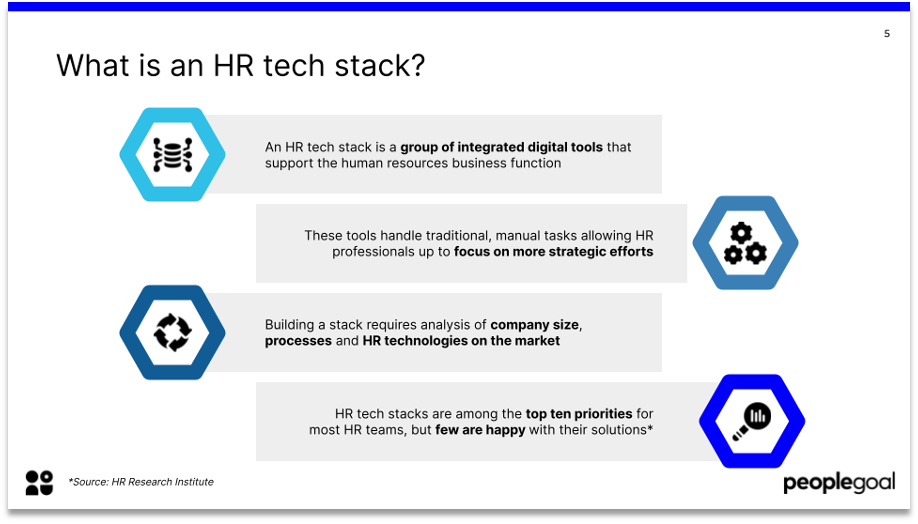
There are many things to consider when consolidating your stack, and it requires careful analysis of company size, processes and the different HR technologies on the market. There is no "one-size-fits-all" solution, and the technology you use will have to reflect your company culture and values.
According to research from the HR Research Institute, whilst HR tech stacks are among the top ten priorities for most HR teams, only 1/4 of those interviewed said their stack was above average. This proves that there is much room for improvement when it comes to HR technology.
Benefits of a strong HR tech stack
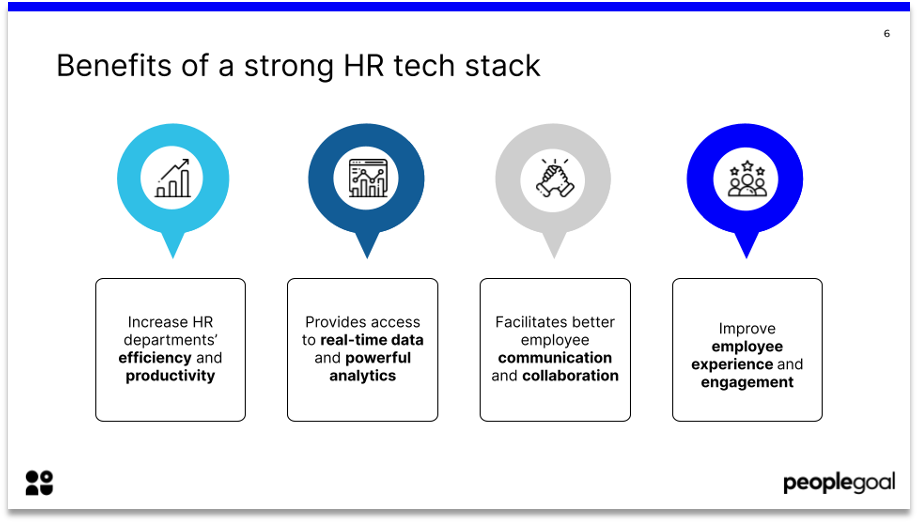
- Increase HR departments’ efficiency and productivity
- Provide access to real-time data and powerful analytics
- Facilitate better employee communication and collaboration
- Improve employee experience and engagement
Key considerations when choosing tools for your tech stack
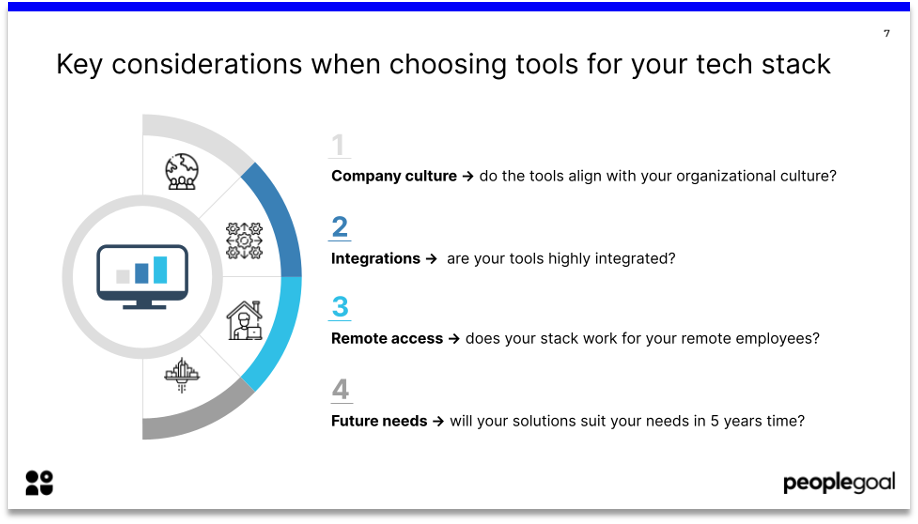
1. Company culture
Do the tools align with your organizational culture? It is essential that the technology you use nurtures and reinforces your company culture. If not, your employees won't engage with it. You need software that represents your values and enables you to run your processes, your way.
2. Integrations
Are your tools highly integrated? One of the key pain points many HR teams face is that their talent management processes do not integrate well. This means that data exists in silos and the employee experience is disjointed. A great HR tech stack should function like a well-oiled machine; it should be seamless to use from both an employee and HR perspective.
3. Remote access
Does your stack work for your remote employees? The remote work trend is here to stay, and many employees want to have the flexibility to work from home when they can. Your HR tech stack therefore needs to support all employees (whether they are in-office or remote) and provide everyone with the same experience. No one should feel excluded from company processes because of their location. Gather remote employee feedback and use it to shape your software decisions.
4. Future needs
Will your solutions suit your needs in 5 years time? The one mistake many make is not considering the future needs of the business, and investing in software with a short-term outlook. It is vital that your HR tech stack has the ability to scale as you grow, so that you never feel boxed-in by your solutions. To avoid this, look for flexible or customizable platforms that allow you to build your processes as you go.
How to get the different tools to work together
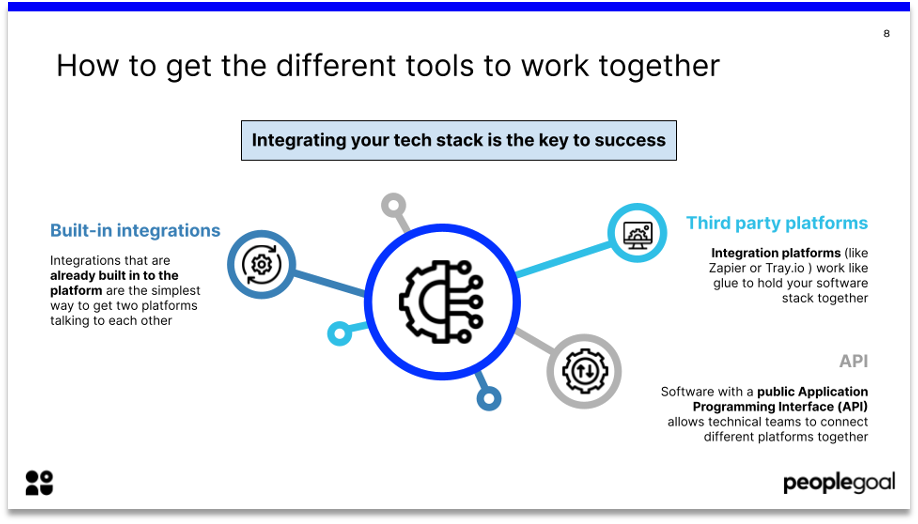
As we mentioned before, one key problem many People Ops teams have cited is that components of their HR tech stack do not integrate well with one another. The aim of using such technology is to automate processes and save time for HR departments - something that cannot happen without slick integrations between different software.
In layman's terms, software integration is when two different systems talk to one another. For example, when employee data from one system (such as name, hire date, job title, salary information etc.) is automatically sent to another system (for example a performance management platform). This saves HR precious time as they will not have to manually input large amounts of employee data. There are many ways two softwares can work in tandem, and we will explain some of them below:
Built-in integrations
Built-in integrations are when a connection between two different softwares is already established and built into one of the platforms you already use. This is the simplest type of integration, as you will not have to involve the technical team. Your software's support center should be able to guide you through how to set up the integration yourself - and will involve only a few easy to follow steps.
Third party platforms
If there is no pre-built connection between the platforms, then you might have to use a third-party platform to get them working together. Integration platforms (like Zapier or Tray.io) automate repetitive tasks for you without you using any code. For example, when an event happens in one app, they can tell another app to perform a particular action.
To do this, you need something called an API - which is an Application Programming Interface. More on that below. These tools will allow you to integrate your entire tech stack, however they do come at a cost.
API
APIs are sets of requirements that govern how one application can communicate and interact with another. Software with a public or open API means that the interface is publicly available to developers, which means that they can easily be connected with another software or app. To complete an integration with APIs you will need to engage your technical team or use a third-party integration platform.
Best tools for your HR Tech Stack
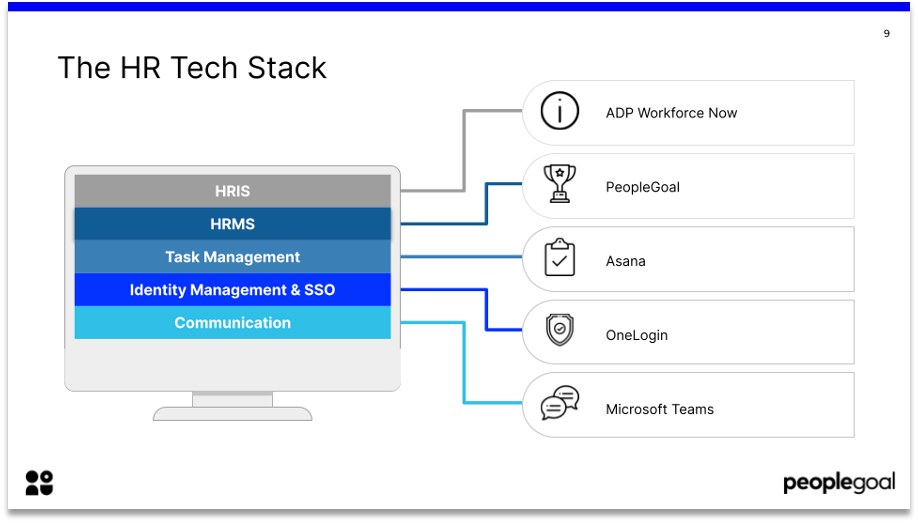
1. HR Information System (HRIS)
An HRIS is the integration of human resources and information technology systems. It enables data entry, and tracking and management for human resources, payroll and accounting. Your HRIS system acts as your central employee database and stores all your employee information. You can also use it for payroll and benefits, and time and attendance tracking. Some systems also come with a talent acquisition functionality, which will save you from using an applicant tracking system.
🌟 Our recommendation: ADP workforce now 🌟
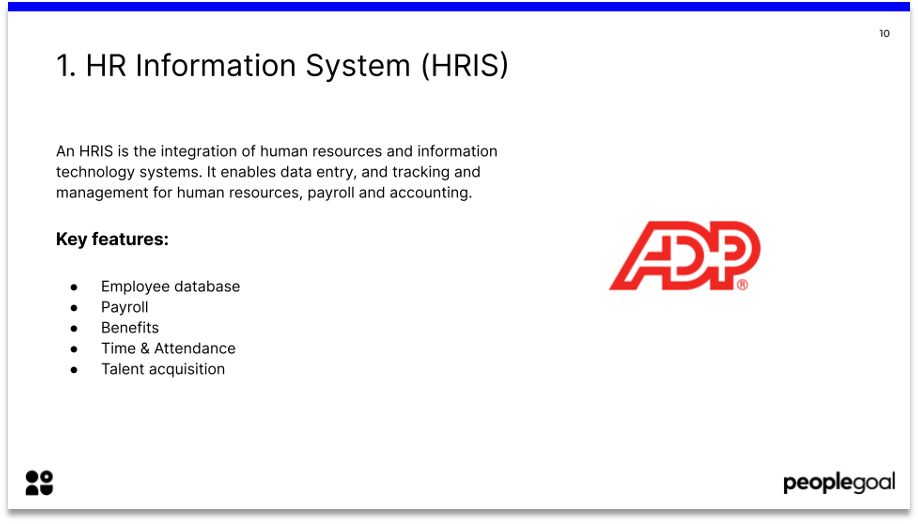
2. HR Management System (HRMS)
An HRMS can be used in onboarding, performance management, succession planning, career progression, performance reviews, and the overall management of employee information within an organization. A good HRMS will cover the key elements during an employee life cycle journey, from onboarding to performance management, engagement and development. You can use it to grow your teams by using employee recognition, performance reviews, 360 feedback and regular check-ins. Your HRMS should be synced with your HRIS so data is consistent across the platforms.
🌟 Our recommendation: PeopleGoal 🌟
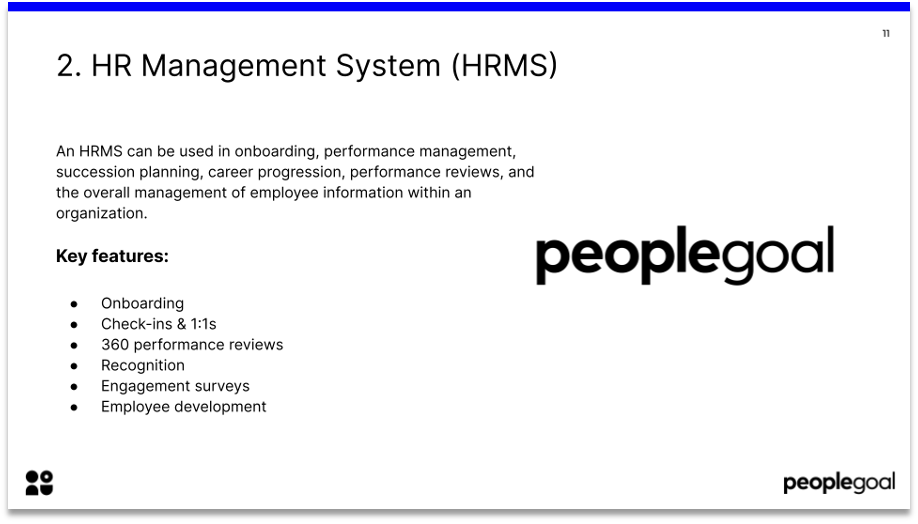
3. Task Management
Task management software is used to manage your tasks, help with the estimation and scheduling, track dependencies, resources and milestones and help you make decisions when changes in priority are needed. Task management software can automate a variety of processes, from project management to kanban boards and to-do lists. You should have your task management software connected with your HRMS, which will allow individual tasks to be linked to goals and other performance processes.
🌟 Our recommendation: Asana 🌟
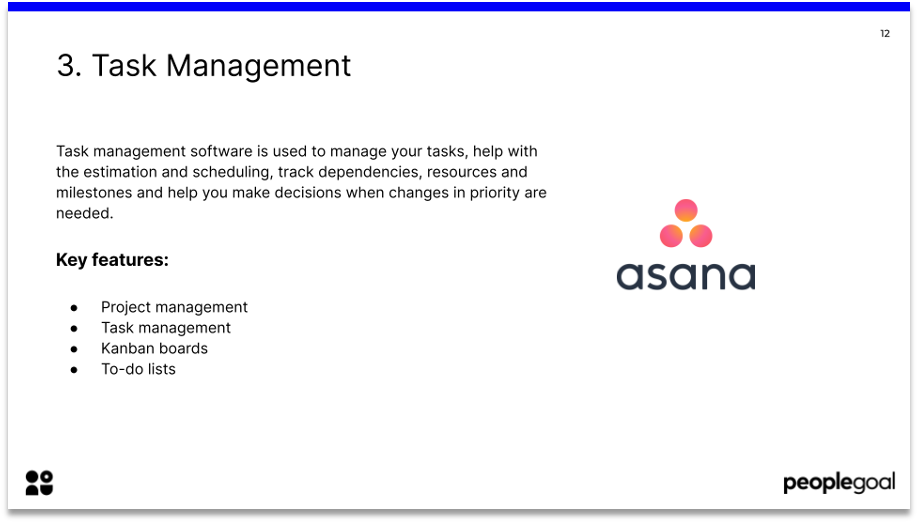
4. Identity & Access Management
Identity and access management (IAM) software helps companies protect their systems from unauthorized access or misuse by only allowing authenticated users to access protected company systems and data. IAM software will allow your employees to use single sign-on, meaning they will only need one login to access all the different systems. They also enable multi-factor authentication, smart factor authentication, identity lifecycle management which all serve to protect both employee and company data.
🌟 Our recommendation: OneLogin 🌟
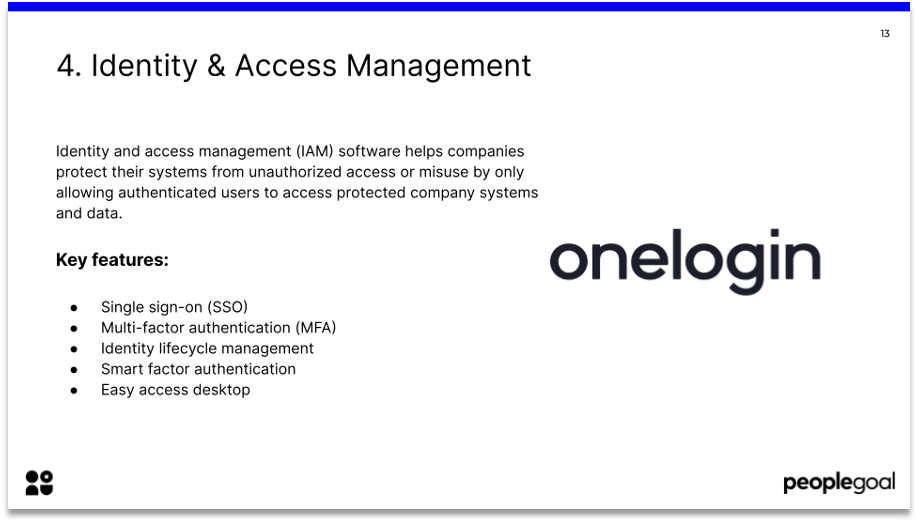
5. Communication tools
Online communication tools allow geographically dispersed teams to collaborate and communicate. They facilitate team collaboration with real-time messaging, file sharing and video conferencing. Hybrid teams with a mix of in-office and remote workers will be able work together efficiently online.
The ideal scenario is to integrate your other tools (HRIS, HRMS, Task Management etc.) with your virtual communication tool so employees receive a notification when they have something to complete. In some instances, employees can even carry out the necessary actions using a functionality within the communication tool without having to leave the system. This creates a more streamlined experience for your teams.
🌟 Our recommendation: Microsoft Teams 🌟
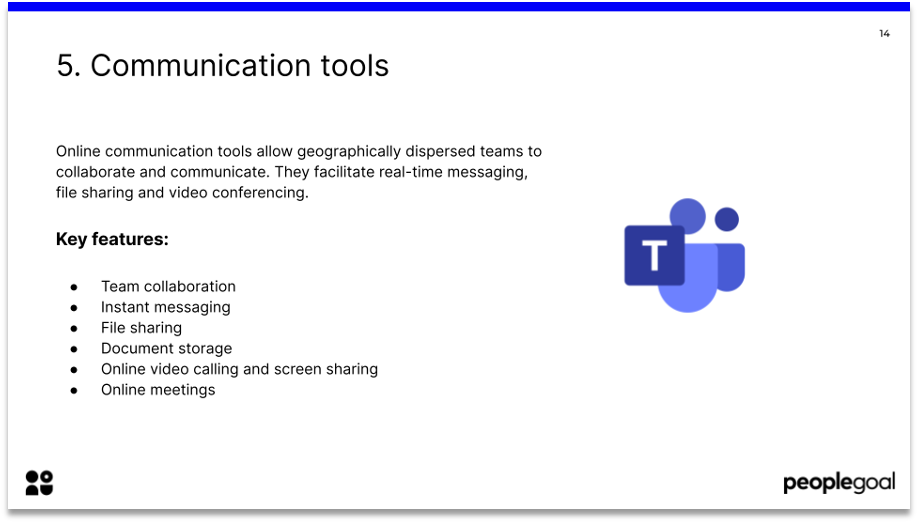
Key takeaways
Don't be intimidated by the different tools and solutions on the market. Select the best providers for your business to better streamline your processes. Make the most of integrations to bring all of your systems together and provide a coherent experience for your teams.
A strong HR tech stack will improve HR efficiency and employee experience
Adopt a continuous frame of mind, tools will need to suit your business needs as you grow
Make sure your tech stack aligns with your company culture
Integrating your HR tech stack is the key to success
👉 Need some help with onboarding, performange management, employee engagement or development? Book a demo with PeopleGoal today!
Catch up with our previous webcasts below: